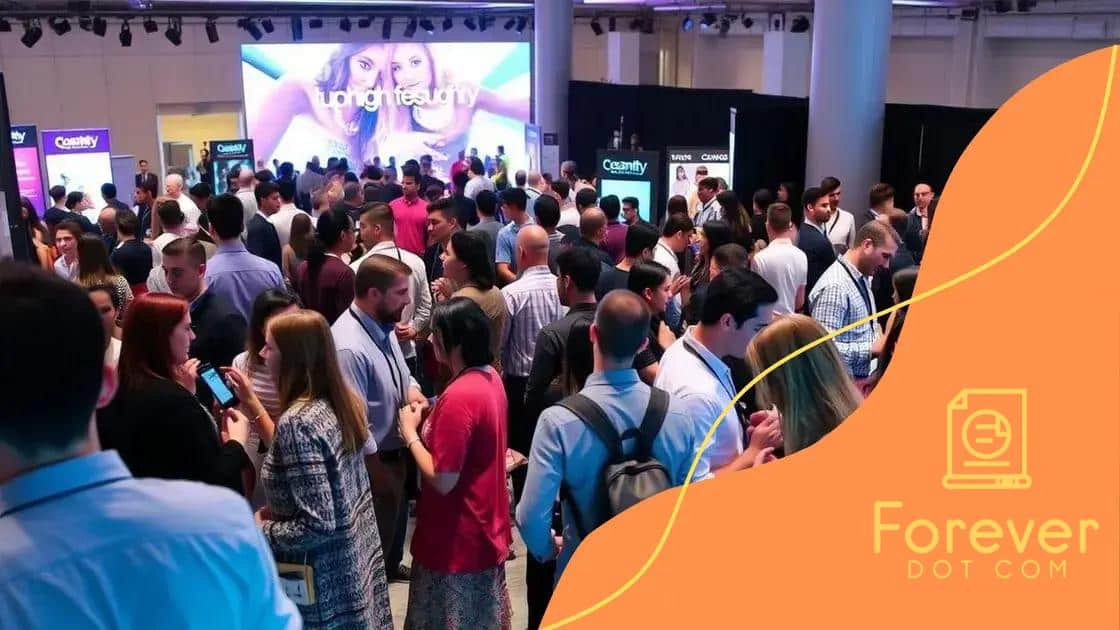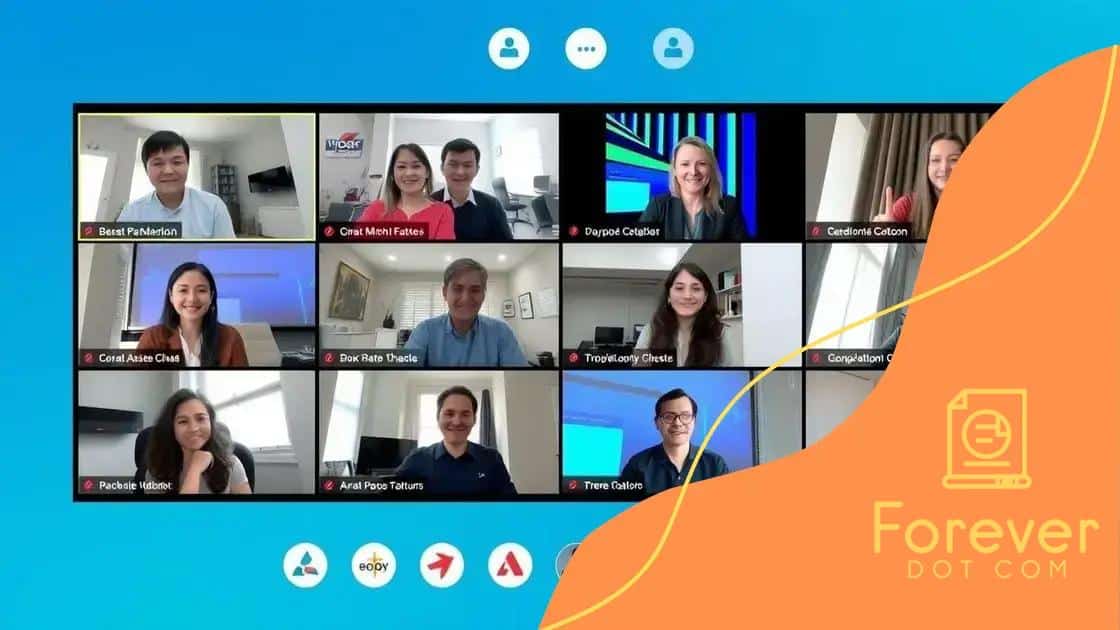Fashion tech conferences shaping industry innovation

Fashion tech conferences are shaping industry innovation by highlighting the integration of smart clothing, augmented reality, and sustainability, while empowering startups to lead in technological advancements.
Fashion tech conferences shaping industry innovation are crucial for connecting creators and innovators. Have you ever wondered how these gatherings influence future trends and technology?
Emerging trends in fashion technology
The emerging trends in fashion technology are transforming the industry at an unprecedented pace. These innovations are not only impacting design but also changing how customers engage with brands.
Smart Fabrics
One of the most exciting developments is the rise of smart fabrics. These materials can adapt to various conditions and offer functionalities like moisture-wicking and temperature regulation. Many brands are experimenting with these fabrics to enhance the overall consumer experience.
- Integration of sensors for health monitoring
- Enhanced durability and sustainability
- Fashion that changes color or texture
Additionally, augmented reality (AR) is becoming a staple in the fashion tech landscape. Brands are now using AR to create virtual fitting rooms that allow customers to try on clothes without physically wearing them. This not only improves the shopping experience but also reduces returns, which is a significant issue in the industry.
Sustainable Practices
Another key trend is sustainability. With growing awareness of environmental issues, companies are shifting towards eco-friendly practices. This includes using recycled materials and implementing circular fashion models. The aim is to reduce waste and promote a more responsible approach to consumption.
- Use of biodegradable materials
- Impacts of fast fashion on the environment
- Consumer demand for transparency
Moreover, data analytics is revolutionizing market trends and consumer insights. By leveraging big data, brands can predict styles that align with evolving customer preferences. This insight allows companies to stay ahead of trends while catering to their audience effectively.
As we look to the future, these emerging trends will continue to shape the fashion industry, enabling innovation while addressing consumer needs and environmental challenges. The integration of technology into fashion is not just a trend; it’s becoming a necessity for survival in a competitive market.
Key players at major conferences
At major fashion tech conferences, the presence of key players significantly influences the advancement of the industry. These influential figures range from innovators to established brands, all showcasing how technology intersects with fashion.
Leading Fashion Brands
Big names like Gucci, Chanel, and Adidas often participate in these events. They share insights into how they integrate technology into their design and marketing processes. Witnessing how these brands innovate can inspire smaller companies and startups.
- Gucci’s use of AI in design
- Chanel’s commitment to sustainability
- Adidas’s focus on smart wearable technology
Emerging designers also play a crucial role at these conferences. They bring fresh perspectives and creative approaches, often highlighting unique materials and production techniques that focus on sustainability. The fusion of creativity and technology enables new voices to enter the fashion tech arena.
Tech Innovators
In addition to fashion brands, tech companies also make their mark at these conferences. The likes of Shopify, Amazon, and specialized tech startups contribute with cutting-edge digital solutions. These companies provide the tools and platforms for brands to grow and reach consumers effectively.
- Shopify’s e-commerce innovations
- Amazon’s logistics advancements
- Startups focused on augmented reality shopping experiences
Moreover, industry experts and influencers serve as moderators and speakers, discussing the future of fashion technology. Their expertise helps attendees grasp the current trends and challenges within the industry, making these discussions invaluable for anyone looking to understand the market.
As we explore the key players at major conferences, it becomes clear that collaboration and innovation are at the forefront of the fashion tech industry. The synergy between fashion and technology brings unique opportunities for growth and transformation.
Impact of virtual events on networking

The impact of virtual events on networking in the fashion tech industry has been profound. As the world shifted towards online interactions, these events transformed how professionals connect and share ideas.
Increased Accessibility
Virtual events allow participants from all over the globe to join in without the barriers of travel. This accessibility opens up opportunities for networking with industry leaders and innovators who might have been previously unreachable. Attendees can easily participate from the comfort of their homes.
- Wider audience reach from diverse locations
- Reduced costs associated with travel and accommodations
- More inclusive access to leading speakers and sessions
Networking at these events often happens in breakout rooms and chat functions. Participants can engage in discussions, share contacts, and even collaborate on projects. This interaction creates a sense of community that is essential for professional growth.
Enhanced Interactivity
Furthermore, virtual platforms offer various interactive tools that facilitate engagement. For example, features like polls, Q&A sessions, and real-time messaging enhance interactions between speakers and attendees. This level of engagement often results in deeper connections and more meaningful discussions.
- Real-time feedback during presentations
- Opportunities to ask questions directly to speakers
- Group discussions fostering collaborative ideas
The evolution of networking in the virtual space has also led to innovative partnerships. Companies and individuals can collaborate easily, share resources, and co-create in ways that were not as feasible in traditional settings.
As these virtual events continue to develop, it is clear that networking is becoming more dynamic. The impact of virtual events on the fashion tech industry will likely influence how professionals connect and collaborate long into the future.
Case studies of innovative startups
Examining case studies of innovative startups in the fashion tech industry reveals how these companies challenge traditional practices. Startups often introduce fresh ideas and technology, making them very influential.
Example: Wearable Technology
One notable startup is Wearable X, which integrates fashion with technology through smart activewear. Their clothing incorporates sensors that provide real-time feedback on performance. This innovation is not just about aesthetics but enhances the user’s experience during workouts, making fitness data easily accessible.
- Real-time performance tracking
- Comfortable and stylish designs
- Integration with mobile apps for personalized feedback
Another interesting example is Notion. This startup focuses on sustainability by using recycled materials in its manufacturing process. By leveraging technology to recycle waste, they create unique clothing lines that appeal to eco-conscious consumers.
Example: Augmented Reality
Startups like Zylo are utilizing augmented reality to create immersive shopping experiences. Customers can try on clothes virtually through their mobile devices, reducing the need for physical fitting rooms. This technology not only improves the shopping experience but also minimizes the environmental impact of returns.
- Enhancing customer engagement through interactive features
- Reducing return rates by allowing virtual try-ons
- Bringing a unique shopping experience to customers
These case studies demonstrate how innovative startups are reshaping the landscape of fashion through technology. As these companies continue to evolve, they set the stage for further advancements within the industry.
Future predictions for fashion tech
Future predictions for fashion tech are exciting and show how technology will continue to shape the industry. With rapid advancements, it’s clear that the integration of tech in fashion is just beginning.
Smart Clothing
One major prediction is the rise of smart clothing. As wearable technology improves, we can expect clothes that monitor health and fitness in real-time. Imagine shirts that track heart rates or jackets that adjust temperature. This shift will change how we view our wardrobe, making clothing functional and fashionable.
- Integration of sensors for health tracking.
- Adaptive materials that respond to environments.
- Enhanced fabrics offering comfort and performance.
Additionally, the impact of artificial intelligence (AI) is set to grow. AI can predict trends by analyzing social media and consumer behavior. This technology will help designers create collections that resonate with market demands, reducing waste and improving efficiency.
Sustainability Innovations
Another key area will be sustainability. Fashion brands are increasingly focusing on eco-friendly practices. Future technologies will likely enhance this trend, making sustainable materials more accessible and affordable. Innovations such as biodegradable fabrics and 3D printing will play a big role in reducing the industry’s carbon footprint.
- Growth of reusable and recyclable materials.
- Increased adoption of circular fashion practices.
- Use of less water and energy in production.
Furthermore, virtual and augmented reality (VR/AR) will redefine the shopping experience. Customers will shop in virtual showrooms, allowing them to try on clothes digitally before making a purchase. This immersive shopping experience will help bridge the gap between online and in-store shopping, creating a seamless experience.
These predictions highlight the continual evolution of fashion tech. As technology advances, we will see a more connected, sustainable, and interactive fashion industry that aligns with consumer values and preferences.
FAQ – Frequently Asked Questions about Fashion Tech Innovation
What are smart clothing technologies?
Smart clothing technologies involve fabrics embedded with sensors that can monitor health parameters and provide real-time data to the wearer.
How does augmented reality enhance the shopping experience?
Augmented reality allows customers to virtually try on clothes, improving their shopping experience by enabling them to see how items fit before purchasing.
What role does sustainability play in fashion tech?
Sustainability is crucial as fashion tech seeks to minimize environmental impact through the use of eco-friendly materials and processes in production.
How can AI influence fashion trends?
AI can analyze consumer behavior and market data to predict trends, helping brands design collections that align with customer preferences.






